
Trichostrongylosis
[Trichostrongylus spp.]
Causal Agents
Nematodes in the genus, Trichostrongylus. Although primarily parasites of animals, several species of Trichostrongylus have been known to infect humans, including T. orientalis, T. colubriformis, and T. axei.
Life Cycle
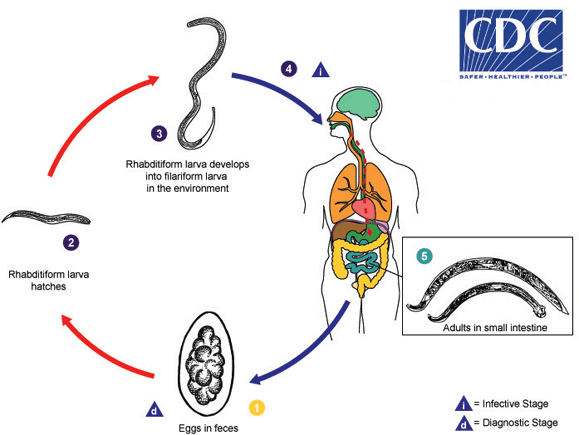
Eggs are passed in the stool of the definitive host (usually a herbivorous mammal)  , and under favorable conditions (moisture, warmth, shade), larvae hatch within several days. The released rhabditiform larvae grow in the soil or on vegetationl
, and under favorable conditions (moisture, warmth, shade), larvae hatch within several days. The released rhabditiform larvae grow in the soil or on vegetationl  , and after 5 to 10 days (and two molts) they become filariform (third-stage) larvae that are infective
, and after 5 to 10 days (and two molts) they become filariform (third-stage) larvae that are infective  . Infection of the human host occurs upon ingestion of these filariform larvae
. Infection of the human host occurs upon ingestion of these filariform larvae  . The larvae reach the small intestine, where they reside and mature into adults. Adult worms inhabit the digestive tract of their definitive hosts and may occur as incidental infections in humans
. The larvae reach the small intestine, where they reside and mature into adults. Adult worms inhabit the digestive tract of their definitive hosts and may occur as incidental infections in humans  .
.
Geographic Distribution
Worldwide, but more common where livestock is raised.
Clinical Presentation
Most infections are asymptomatic. Heavy infections can cause gastrointestinal problems (abdominal pain, diarrhea, anorexia), headache, fatigue, anemia and eosinophilia.
Trichostrongylus spp. eggs in wet mounts.

Figure A: Egg of Trichostrongylus sp. in an unstained wet mount of stool.
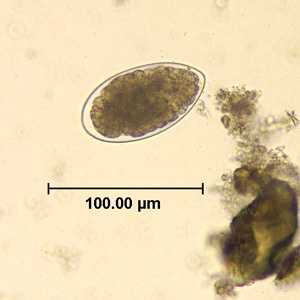
Figure B: Egg of Trichostrongylus sp. in an unstained wet mount of stool.

Figure C: Egg of Trichostrongylus sp. in an unstained wet mount of stool. Image courtesy of the Indiana State Department of Health.
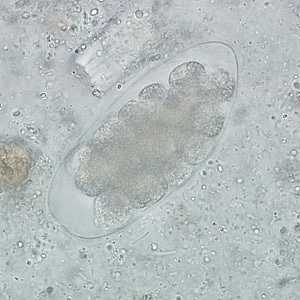
Figure D: Egg of Trichostrongylus sp. in an unstained wet mount of stool. Image courtesy of the Indiana State Department of Health.
Trichostrongyle eggs in wet mounts.

Figure A: Egg of a Trichostrongyle in an unstained wet mount of stool from a patient from Afghanistan. Eggs ranged in size from 87-92 µm in length by 50-55 µm in width. Images courtesy of the Leiden University Medical Center, The Netherlands.
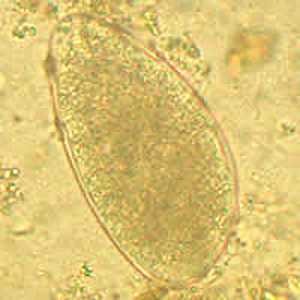
Figure B: Egg of a Trichostrongyle in an unstained wet mount of stool from a patient from Afghanistan. Eggs ranged in size from 87-92 µm in length by 50-55 µm in width. Images courtesy of the Leiden University Medical Center, The Netherlands.
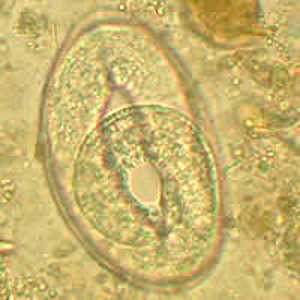
Figure C: Egg of a Trichostrongyle from the same specimen as Figures A and B. In this egg, a developing larva can be observed.
Trichostrongylus adults.

Figure A: Anterior end of a female Trichostrongylus sp. Image of a glycerin-mounted specimen, taken at 200x magnification.
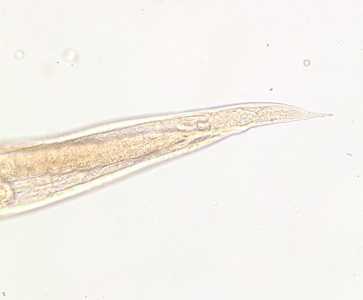
Figure B: Posterior end of the same specimen as Figure A. Note the pointed tail. Image taken at 200x magnification.
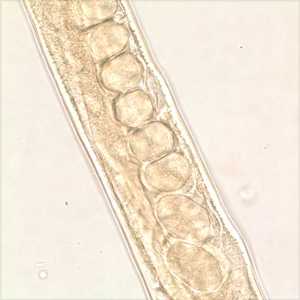
Figure C: Midsection of the same specimen from Figures A and B. Note a row of eggs in the uterus.

Figure D: Posterior end of a male Trichostrongylus sp. Note the presence of a bursa (red arrow) and spicule (blue arrow). of a glycerin-mounted specimen, taken at 200x magnification.
Laboratory Diagnosis
Microscopic identification of eggs in feces is evidence of infection. Because eggs may be difficult to find in light infections, a concentration or flotation procedure is recommended. Patients may have co-infections with hookworm, so care must be taken to differentiate the two.
Treatment Information
Infection with Trichostrongylus spp. has been successfully treated with pyrantel pamoate, 11mg/kg once, or albendazole, 400mg orally per day for 4 days. In settings where veterinary anthelminthics pressure may have led to the development of presumed helminth resistance, ivermectin (200 μg/kg given as a single oral dose) has been used successfully.
DPDx is an education resource designed for health professionals and laboratory scientists. For an overview including prevention and control visit www.cdc.gov/parasites/.
- Page last reviewed: May 3, 2016
- Page last updated: May 3, 2016
- Content source:
- Global Health – Division of Parasitic Diseases and Malaria
- Notice: Linking to a non-federal site does not constitute an endorsement by HHS, CDC or any of its employees of the sponsors or the information and products presented on the site.
- Maintained By:


 ShareCompartir
ShareCompartir